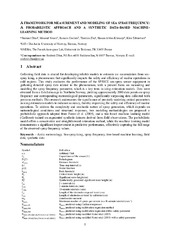A framework for measurement and modeling of sea spray frequency: A probabilistic approach and a synthetic data-based machine-learning method
Permanent link
https://hdl.handle.net/10037/38007Date
2025-06-29Type
Journal articleTidsskriftartikkel
Peer reviewed
Author
Dhar, Sushmit; Naseri, Masoud; Ceolato, Romain; Zhu, Tiantian; Khawaja, Hassan Abbas; Edvardsen, KåreAbstract
Collecting field data is crucial for developing reliable models to estimate ice accumulation from sea spray icing, a phenomenon that significantly impacts the safety and efficiency of marine operations in cold regions. This study evaluates the performance of the SPRICE sea spray sensor equipment in gathering detailed spray data related to the phenomenon, with a present focus on measuring and modeling the spray frequency parameter, which is a key term in icing estimation models. Data were obtained from a fish farm cage in Northern Norway, yielding approximately 2000 data points on spray frequency and corresponding meteorological parameters, significantly surpassing data collected with previous methods. This research underscores the significance of precisely modeling critical parameters in icing estimation models to enhance accuracy, thereby improving the safety and efficiency of marine operations. To address the complexity and stochastic nature of spray generation, which depends on meteorological conditions and structural responses, two modeling methodologies are proposed: a probabilistic approach adapted from Forest et al., and a tree-based machine-learning model (CatBoost) trained on augmented synthetic datasets derived from field observations. The probabilistic model offers a conservative and straightforward estimation method, while the machine-learning model demonstrates a significant improvement in predictive performance, effectively capturing the full range of the observed spray frequency values.
Publisher
WileyCitation
Dhar S, Naseri N, Ceolato, Zhu T, Khawaja HA, Edvardsen K. A framework for measurement and modeling of sea spray frequency: A probabilistic approach and a synthetic data-based machine-learning method. Quarterly Journal of the Royal Meteorological Society. 2025Metadata
Show full item recordCollections
Copyright 2025 The Author(s)


 English
English norsk
norsk